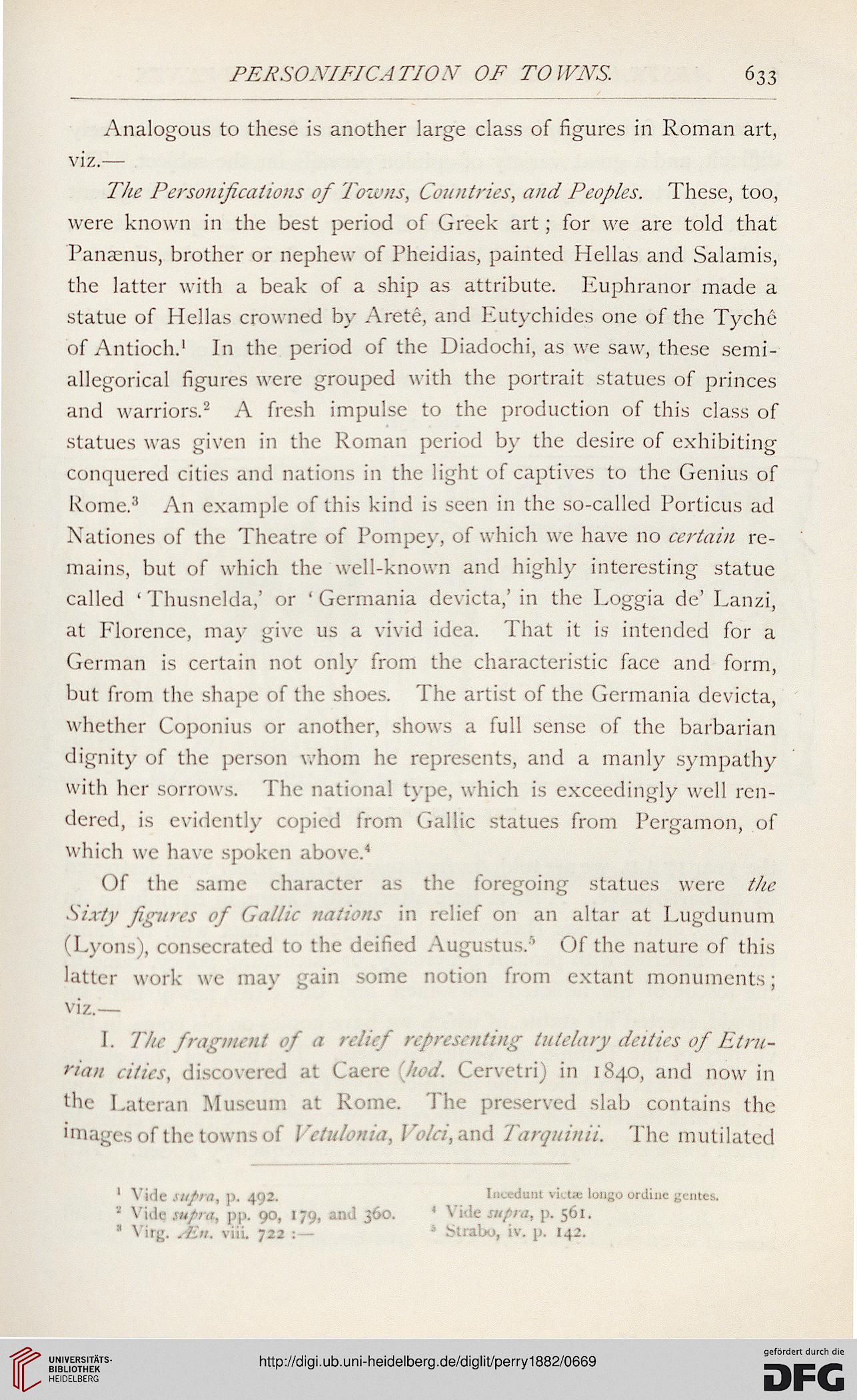PERSONIFICATION OF TOWNS.
633
Analogous to these is another large class of figures in Roman art,
viz.—
The Personifications of Towns, Countries, and Peoples. These, too,
were known in the best period of Greek art; for we are told that
Panxnus, brother or nephew of Pheidias, painted Hellas and Salamis,
the latter with a beak of a ship as attribute. Euphranor made a
statue of Hellas crow ned by Arete, and Eutychides one of the Tyche
of Antioch.1 In the period of the Diadochi, as we saw, these semi-
allegorical figures were grouped with the portrait statues of princes
and warriors.2 A fresh impulse to the production of this class of
statues was given in the Roman period by the desire of exhibiting
conquered cities and nations in the light of captives to the Genius of
Rome.3 An example of this kind is seen in the so-called Porticus ad
Nationes of the Theatre of Pompey, of which we have no certain re-
mains, but of which the well-known and highly interesting statue
called ' Thusnelda,1 or ' Germania devicta,' in the Loggia de' Lanzi,
at Florence, may give us a vivid idea. That it is intended for a
German is certain not only from the characteristic face and form,
but from the shape of the shoes. The artist of the Germania devicta,
whether Coponius or another, shows a full sense of the barbarian
dignity of the person whom he represents, and a manly sympathy
with her sorrows. The national type, which is exceedingly well ren-
dered, is evidently copied from Gallic statues from Pergamon, of
which we have spoken above.4
Of the same character as the foregoing statues were the
Sixty figures of Gallic nations in relief on an altar at Lugdurtum
(Lyons), consecrated to the deified Augustus.'' Of the nature of this
latter work we may gain some notion from extant monuments;
viz.—
I. The fragment of a relief representing tutelary deities of Etru-
rian cities, discovered at Caere (hod. Cervetri) in 1840, and now in
the Lateran Museum at Rome. The preserved slab contains the
images of the towns of Vctulonia, Void, and Tarquinii. The mutilated
' Vide inpra, p. 492.
• Vide supra, pp. 90, I
* Viry. Jin. viii. 722 :
633
Analogous to these is another large class of figures in Roman art,
viz.—
The Personifications of Towns, Countries, and Peoples. These, too,
were known in the best period of Greek art; for we are told that
Panxnus, brother or nephew of Pheidias, painted Hellas and Salamis,
the latter with a beak of a ship as attribute. Euphranor made a
statue of Hellas crow ned by Arete, and Eutychides one of the Tyche
of Antioch.1 In the period of the Diadochi, as we saw, these semi-
allegorical figures were grouped with the portrait statues of princes
and warriors.2 A fresh impulse to the production of this class of
statues was given in the Roman period by the desire of exhibiting
conquered cities and nations in the light of captives to the Genius of
Rome.3 An example of this kind is seen in the so-called Porticus ad
Nationes of the Theatre of Pompey, of which we have no certain re-
mains, but of which the well-known and highly interesting statue
called ' Thusnelda,1 or ' Germania devicta,' in the Loggia de' Lanzi,
at Florence, may give us a vivid idea. That it is intended for a
German is certain not only from the characteristic face and form,
but from the shape of the shoes. The artist of the Germania devicta,
whether Coponius or another, shows a full sense of the barbarian
dignity of the person whom he represents, and a manly sympathy
with her sorrows. The national type, which is exceedingly well ren-
dered, is evidently copied from Gallic statues from Pergamon, of
which we have spoken above.4
Of the same character as the foregoing statues were the
Sixty figures of Gallic nations in relief on an altar at Lugdurtum
(Lyons), consecrated to the deified Augustus.'' Of the nature of this
latter work we may gain some notion from extant monuments;
viz.—
I. The fragment of a relief representing tutelary deities of Etru-
rian cities, discovered at Caere (hod. Cervetri) in 1840, and now in
the Lateran Museum at Rome. The preserved slab contains the
images of the towns of Vctulonia, Void, and Tarquinii. The mutilated
' Vide inpra, p. 492.
• Vide supra, pp. 90, I
* Viry. Jin. viii. 722 :




